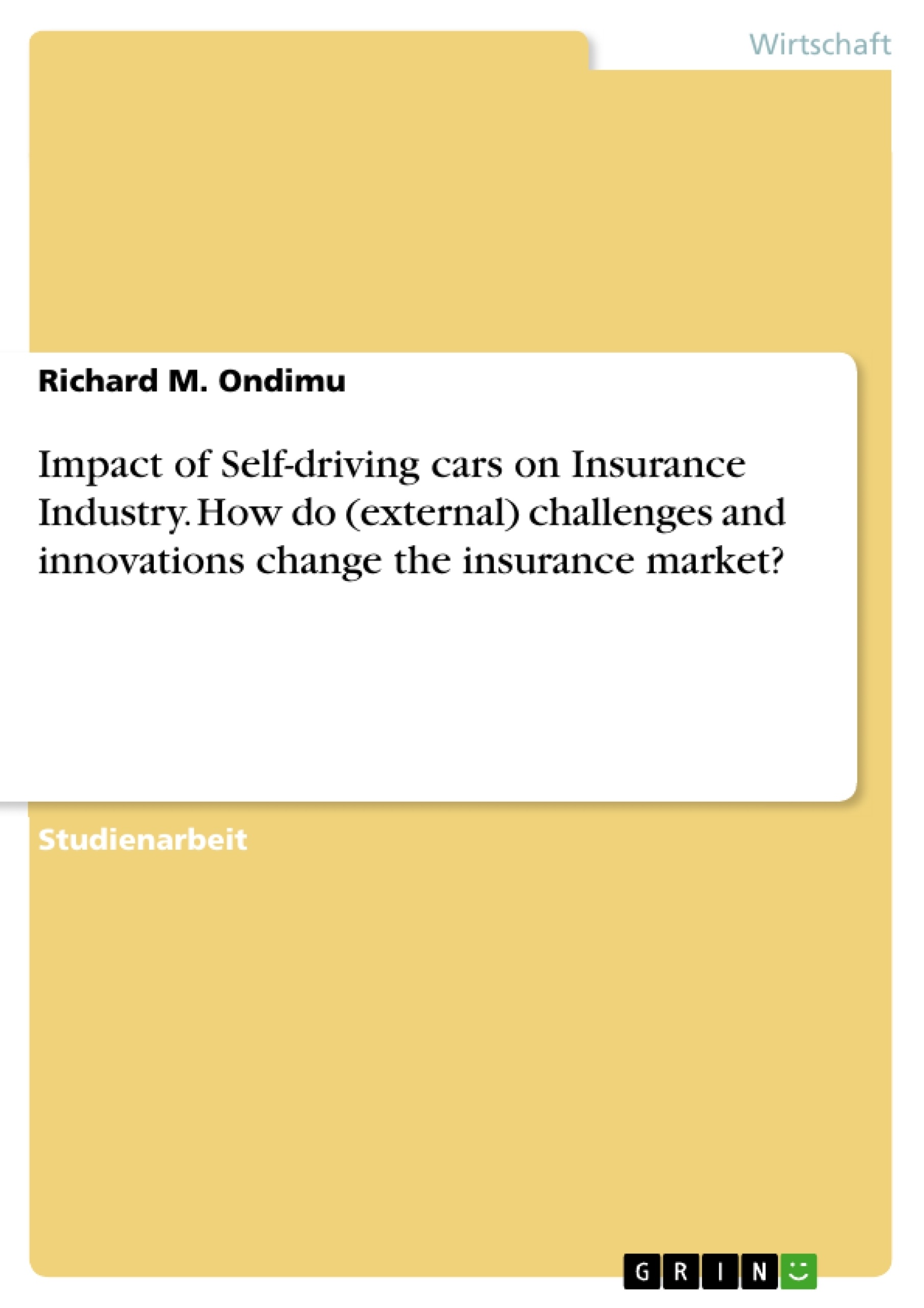The future may be uncertain and hard to predict, but it should not be hard to prepare for. Internet and other digital platforms have transformed the way people interact and how they do business in almost all sectors of the economy. This has led to far-reaching challenges and innovations that could have an impact on both current and future of numerous economic sectors. In insurance, for instance, a sector which has remained largely the same for more than three decades, it has a great influence on its value chain right from production, sales and distribution to claims and payments.
This report examines self-driving cars, a digital innovation involving vehicles with the capacity to sense their environment and navigate through the pathways without human driver inputs. Their ability to analyze sensory data that in return enables them distinguish between different cars in the road increases driving efficacy and as a result likely to alter current state of both automobile and life insurance industry substantially because of the likelihood that their adoption will significantly reduce the number of traffic accidents as majority of road accidents traditionally are perceived to be caused by driver error/negligence consequently shrinking insurance bills and claims for customers.
This study further examines how this innovation (autonomous cars) would influence insurance markets/business while exploring the various responses which the insurance industry has/will put in place to help cope with these changes in the future to enable them to remain sustainably relevant in the market.
Inhaltsverzeichnis
- Introduction
- Self-driving vehicle Innovation/Technology
- Traditional Car Insurability Criteria
- Other affected sectors and their coping strategies with self-driving cars
- Impact of Self-driving cars on Insurance Industry
- Alteration of the insurance Value Chain
- Reduced Demand for Insurance - Lower Premiums and Potential Revenues
- Pricing and Underwriting
- Impact on claims
- Response Strategies by the Insurance Industry
- The future of insurance industry with Autonomous Vehicles
Zielsetzung und Themenschwerpunkte
Dieser Bericht analysiert die Auswirkungen von selbstfahrenden Autos, einer digitalen Innovation, auf die Versicherungsbranche. Der Fokus liegt auf den Veränderungen, die diese Technologie für die Wertschöpfungskette der Versicherung, die Nachfrage nach Versicherungsprodukten, die Preisgestaltung, die Schadenbearbeitung und die Reaktion der Versicherungsbranche mit sich bringt.
- Auswirkungen von selbstfahrenden Autos auf die Versicherungsbranche
- Veränderungen in der Wertschöpfungskette der Versicherung
- Geringere Nachfrage nach Versicherungen und potenzielle Umsatzrückgänge
- Preisgestaltung und Underwriting
- Reaktionen der Versicherungsbranche auf die Veränderungen
Zusammenfassung der Kapitel
- Introduction: Die Einleitung stellt den Kontext der Untersuchung dar und beleuchtet die Auswirkungen digitaler Innovationen auf verschiedene Wirtschaftsbereiche, insbesondere die Versicherungsbranche. Die Bedeutung von selbstfahrenden Autos als digitale Innovation und deren potenziellen Einfluss auf die Automobil- und Lebensversicherungswirtschaft werden hervorgehoben.
- Self-driving vehicle Innovation/Technology: Dieses Kapitel beschreibt die Funktionsweise von selbstfahrenden Autos und deren Fähigkeit, die Umgebung wahrzunehmen, Entscheidungen zu treffen und sich ohne menschliches Zutun zu bewegen. Es beleuchtet die Entwicklung dieser Technologie, von den ersten Konzepten bis zu den aktuellen Fortschritten von Unternehmen wie Google, Tesla und anderen.
- Traditional Car Insurability Criteria: Dieses Kapitel behandelt die traditionellen Kriterien für die Versicherbarkeit von Kraftfahrzeugen, wie z.B. Alter des Fahrers, Beruf, Unfallhistorie, Fahrzeugmodell und Umgebung. Es untersucht, wie diese Kriterien durch das Aufkommen von selbstfahrenden Autos möglicherweise hinfällig werden, da die menschliche Komponente entfällt.
- Other affected sectors and their coping strategies with self-driving cars: Dieses Kapitel untersucht die Auswirkungen von selbstfahrenden Autos auf andere Wirtschaftsbereiche, insbesondere die Automobilindustrie, die bereits stark von dieser Entwicklung betroffen ist. Es beleuchtet die Reaktionen und Anpassungen der verschiedenen Branchen, um sich auf die kommenden Veränderungen einzustellen.
- Impact of Self-driving cars on Insurance Industry: Dieses Kapitel analysiert die Auswirkungen von selbstfahrenden Autos auf die Versicherungsbranche. Es betrachtet die Veränderungen in der Wertschöpfungskette, die potenzielle Verringerung der Nachfrage nach Versicherungen aufgrund der erhöhten Sicherheit, die veränderte Preisgestaltung und das Underwriting sowie die Auswirkungen auf die Schadenbearbeitung.
Schlüsselwörter
Die Schlüsselwörter und Schwerpunktthemen dieses Berichts sind selbstfahrende Autos, digitale Innovationen, Versicherungsbranche, Wertschöpfungskette, Nachfrage nach Versicherungen, Preisgestaltung, Underwriting, Schadenbearbeitung, Reaktionen der Branche, Auswirkungen auf andere Wirtschaftsbereiche.
- Quote paper
- Richard M. Ondimu (Author), 2016, Impact of Self-driving cars on Insurance Industry. How do (external) challenges and innovations change the insurance market?, Munich, GRIN Verlag, https://www.grin.com/document/379068



